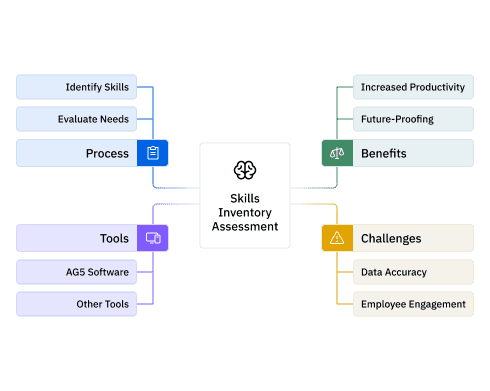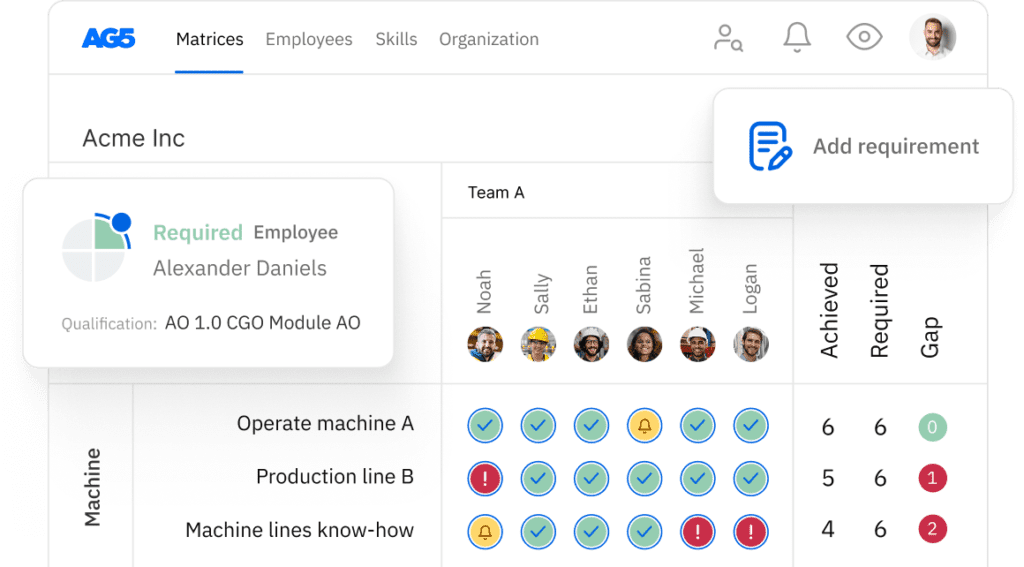How to conduct a skills inventory assessment and close skill gaps
Discover how a skills inventory assessment can boost efficiency, close skills gaps, and enhance workforce planning. Learn the step-by-step process, benefits, challenges, and how tools like AG5 can simplify skills management.

Skills-based organizations not only run more efficiently and are more future-proof, they’re also up to 40% more productive. [1] Building such an organization, however, requires comprehensive knowledge of the skills your employees have and need. One such way to acquire such an understanding is with a skill inventory assessment.
In this article, we’ll provide you with a step-by-step guide to conducting a skills inventory assessment in your organization, as well as shine some light on its many benefits, a few challenges you may face, and tools such as AG5’s skills management software that can help streamline the process.
What is a skills inventory assessment?Copied
A skills inventory assessment is a process you can use to identify, evaluate, and analyze the skills, knowledge, certifications, and abilities that your employees possess and need. They can help business leaders manage their employees’ (and their own) skills, set goals for skill development, and close skills gaps.
How to assess your skills inventoryCopied
A skills inventory assessment is a multistep process. While it may be time-consuming, it is important to be as thorough as possible. A detail-oriented approach to a skills inventory assessment is extremely important in achieving the best – and most accurate – results possible. Here’s how you can conduct an effective skills inventory assessment.
Define your goals
Start by determining why you are assessing your skills inventory. Common reasons here might include identifying skill gaps for training programs, preparing for new projects, or supporting workforce and succession planning. Also, be sure to set clear and concretely measurable objectives, such as identifying leadership skill gaps across 20% of your workforce.
Create a skills matrix
Your skills matrix should include and categorize the skills and competencies your organization has and needs. This should include soft skills, hard skills, and any skills you believe may be necessary in the future, such as those related to IoT or digital transformation. You should also be sure to include any certifications or training that are necessary for your organization to run effectively and efficiently.
To get started with a pre-made skills matrix, you can refer to our article, “8 free skills matrix templates & samples.” Or, to create one of your own, read our “Ultimate Guide to Creating an Excel Skills Matrix.”
Collect data
To gather the information you’ll need for your skills inventory assessment, you can rely on several – and typically a combination of – methods. Here are a few that we have found to be effective.
- Surveys or questionnaires for employees to rate their own skills
- Feedback from managers, team leaders, and colleagues
- Existing HR data, such as past performance reviews, resumes, certifications, and training records
- Practical skill tests or job-specific simulations – especially for roles that require hands-on evaluation
Analyze and identify skill gaps
Compare the skills, competencies, and certifications that currently exist in your organization, to those that are lacking or otherwise necessary. This comparison will help you identify skill gaps that require your attention, allowing you to take steps toward closing them through targeted training, upskilling, or recruitment initiatives.
The benefits of assessing your skills inventoryCopied
Skills inventory assessments are important for several major reasons. In this section, we’ll take a look at a few of them.
Identifying skill gaps
By conducting a skills inventory assessment, you can identify skill gaps that may exist in your departments or team, which is a top goal for many skills-based organizations. [2] This can help you determine which team members may need additional training or development, as well as identify potential areas where you may need to recruit new talent.
Performance evaluations
A skills inventory can also be used to evaluate the employees’ performance. By comparing their skills and abilities to the requirements of their role, you can assess whether they are performing at an appropriate level, and whether there are any areas where they may need to improve with training or certification courses.
Career development
A skills inventory can also be used to support your employees’ career development through upskilling and reskilling. [3] By understanding their skills and goals, you can help them identify potential career paths within the organization and work with them to set goals for skill development.
Organizational planning
With a comprehensive understanding of your employees’ skills, you can better allocate resources and plan for the future. For example, if you identify a skill gap in your team, you can work with HR to reskill or upskill existing employees – or recruit new ones – to fill it.
Common challenges in conducting skills inventory assessmentsCopied
Conducting a skills inventory assessment is not usually an easy process. This means there are many challenges they pose to organizations – especially those that are large or complex. Here, we’ll lay out a few of the most common challenges we see organizations face when conducting a skills inventory assessment, as well as how you can effectively approach them.
- Lack of focus. Without clear, concrete goals, skills inventories can become disorganized and unproductive. Define objectives upfront, such as identifying gaps, workforce planning, or training needs to keep your skills inventory assessment focused
- Complex data collection methods. The process of gathering and organizing workforce skill data can be overwhelming, especially in large organizations. Take strides to centralize, simplify, and align your methods of data collection, so that all your sites, departments, and teams are on the same page
- Collecting too much data. Prioritize the critical skills that are linked to organizational goals and break data into manageable segments to ensure practical, actionable insights.
- Difficulty measuring soft skills. Skills like communication or leadership are often harder to quantify. You can use behavioral assessments, 360-degree feedback, and scenario-based evaluations to effectively measure them
- Lack of an action plan. A skills inventory assessment is only the first step in closing skill gaps, which means you’ll also need a plan to address them. This should include implementing training programs, tracking progress, and continuously updating your skills inventories and matrices
Tools and software to simplify skills inventory managementCopied
Conducting a skills inventory assessment is indeed a complex task. However, there are many tools and software you can use to simplify and streamline the process.
Our blog “LMS, TMS, KMS, HRM, and CMS: What’s the difference?” takes you through many of your options there.
Of course, AG5’s skills management software can help create and maintain skills inventories by providing a platform on which organizations can input and manage employee skills data, including education, certifications, training, and experience. This information can be used to identify skills gaps, plan training and development programs, and optimize workforce planning.
With AG5, you can:
- Create and use skills matrices
- Use the “Expert Finder” tool to find suitable replacements or successors
- Leverage skills and requirement libraries to categorize and structure the skills and qualifications present in your organization
- Track and manage training plans
- Trigger automated emails, SMS notifications, or API calls based on various conditions that will help you plan ahead and renew expiring certifications
Combined, these features work to help you create and enhance skills inventories, so you can ensure your organization closes or avoids skills gaps – stays current, compliant, safe, and ready for the future.
Ready to conduct a skills inventory assessment with AG5?Copied
Ready to take the first step on your skills management journey by conducting a thorough skills inventory assessment? Get in touch today for a free, live 15-minute demo, which will give you a customized look at what AG5 can do for your organization.
Sources Copied
- Change view: Table
-
APA
| # | Source title | Description | Publication | Retrieved | Source URL |
|---|---|---|---|---|---|
| 1 | Using skill gap assessments to help future-proof your organization | McKinsey | May 23, 2022 | December 13, 2024 | https://www.mckinsey.com/capab.. |
| 2 | Skills-based transformation: Where should you start? | Deloitte | October 2, 2022 | December 13, 2024 | https://action.deloitte.com/in.. |
| 3 | Beyond hiring: How companies are reskilling to address talent gaps | McKinsey | February 12, 2022 | December 13, 2024 | https://www.mckinsey.com/capab.. |
Author Copied
Revisions Copied
Written by: Rick van Echtelt
Copy edited by: Adam Kohut

